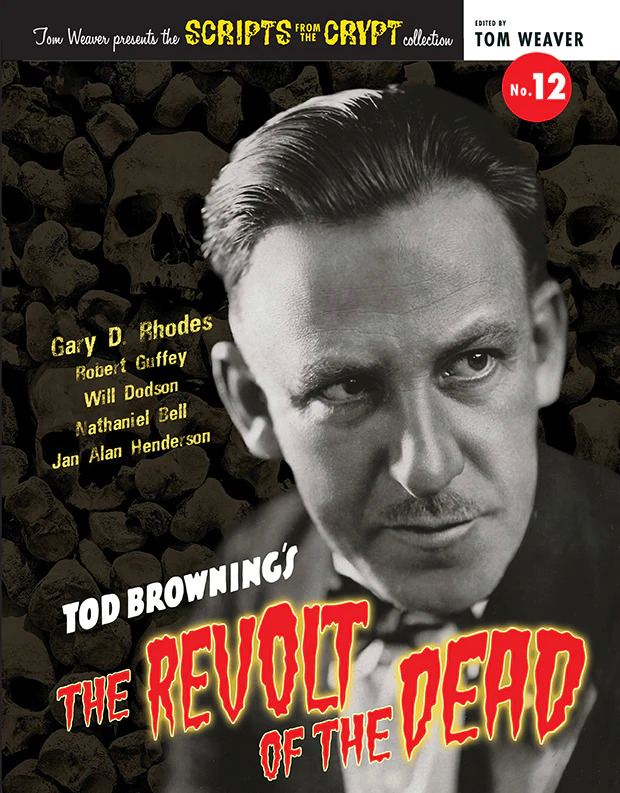
Parallax Views w/ J.G. Michael
Society & Culture

Tod Browning and the Unmade 1930s Zombie Apocalypse Movie THE REVOLT OF THE DEAD w/ Gary D. Rhodes and Robert Guffey
 2022-10-27
2022-10-27
On this spooky season edition of Parallax Views, film scholar Gary D. Rhodes, one of the foremost authorities on Bela Lugosi and classic horror cinema, and Robert Guffey return to the show to discuss their new edited volume Scripts from the Crypt No. 12: Tod Browning's Revolt of the Dead.
Tod Browning is perhaps best known for director 1931's Dracula. Starring Bela Lugosi as the titular vampire count, a role which he'd become inextricably linked to for the rest of his career, Dracula was a massive success for Hollywood's depression era Universal Studios and launched that studios foray into making wildly popular creatures features for the next three decades. Before The Creature from the Black Lagoon, Frankenstein, The Invisible Man, and The Mummy there was Tod Browning's Dracula.
Browning, however, wasn't new to either Hollywood or weaving tales of the macabre for the silver screen. Born on July 12, 1880, Browning ran was fascinated from a young age by carnivals and eventually ran away from home to join a traveling circus. From there he'd transition to acting and, finally, becoming a director. In the silent film era, Browning became known for his collaborations with Lon Chaney, Sr., who became known as "The Man of a Thousand Faces" and whose credits include such classics as The Hunchback of Notre Dame and The Phantom of the Opera. Together, Browning and Chaney told macabre tales involving themes like violence and mutilation in films like West of Zanzibar, The Unholy Three, The Unknown, and the infamously lost London After Midnight. Browning would then go on to direct Dracula before making other films such as the controversial Freaks (featuring real-life circus people) his London After Midnight talkie remake Mark of the Vampire.
In this conversation Gary, Robert and I discuss:
- An introduction to the Scripts from the Crypt series founded by film historian Tom Weaver
- Biographical background on Tod Browning, who was often spoken of as the Edgar Allen Poe of filmmakers in his time and his influence on filmmakers and artists including Ray Bradbury, Alejandro Jodorowsky, and Woody Allen
- The critical beating Browning has taken over the years and why Gary argues that it's mistaken; the Spanish Dracula vs. Browning's Dracula; Browning's transition from the silent films to talking motion pictures; Browning's collaborations with Lon Chaney Sr. and the horror elements in them
- Browning's light-hearted murder mystery Miracles for Sale; Browning's early talkie The Thirteenth Chair starring Bela Lugosi (before Dracula) and its taking on the subject of spiritualist conmen/frauds; Browning's silent films such as West of Zanzibar, The Unknown, and The Unholy Three
- Tod Browning's thematic obsessions: trickery, fakery, deception, mutilation, sexual frustration, and more; the different kinds of trickery dealt with in Browning's films; harmless truths vs. dangerous lies and swindling; skepticism towards medium, seances, and the supernatural; women and how they are portrayed in Browning's movies (such as Carol Borland's Luna in Mark of the Vampire); the Scooby Doo-eqsue element of Browning's murder mysteries
- Tod Browning's Freaks; a movie that used real-life circus people; the film's subversive quality by way of its making viewers sympathize with the circus people and treating the "normal" people as the villains; the question of Freaks success and its effect on Browning's career; mentioning how the pop punk band The Ramones were influenced by Freaks; the role of vaudeville, circuses, and sideshow life on Browning's work
- The Browning script/treatment for the unmade movie Revolt of the Dead; the movie would've predated William Friedkin's The Exorcist and Night of the Living Dead in dealing with now common horror tropes like demonic possession and the zombie apocalypse; Revolt of the Dead would've even included human crucifixions; the story would've also included the phenomena of stigmata, the inexplicable appearance of wounds on the wrists like those of Jesus Christ during the crucifixion; the unique qualities of the script
- Tod Browning's Londo After Midnight, the "Holy Grail" of lost films; the rumors, legends, hoaxes around the movie ever since it was destroyed in a fire at the MGM vault; the iconic image of Lon Chaney Sr;. in scar make-up for London After Midnight; other lost films including F.W. Murnau's Der Januskopf (aka The Head Janus; starring Conrad Veidt and Bela Lugosi) and the 1959 Bela Lugosi-headlining chiller Lock Up Your Daughters
- Robert' novel Bela Lugosi's Dead, which deals with a man searching for the lost test footage of Lugosi as Frankentein's monster
- The Revolt of the Dead in relationship to White Zombie, William Seabrook's Magic Island novel and its success, American military involvement in Haiti, and racist/xenophobic sentiments about Haiti in the early 20th century
- Appreciating early 20th century cinema; getting past the "I can't watch Black-and-White movies" mentality; the rewarding aspect of watching classic movies
- Tod Browning and the Grand Guignol, the theater tradition in France obsessed with the gruesome and grotesque
And much, much more!
More Episodes
Create your
podcast in
minutes
- Full-featured podcast site
- Unlimited storage and bandwidth
- Comprehensive podcast stats
- Distribute to Apple Podcasts, Spotify, and more
- Make money with your podcast
It is Free
- Privacy Policy
- Cookie Policy
- Terms of Use
- Consent Preferences
- Copyright © 2015-2024 Podbean.com





